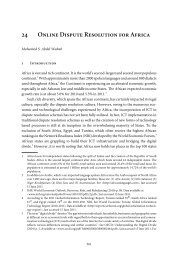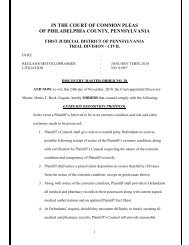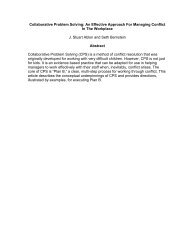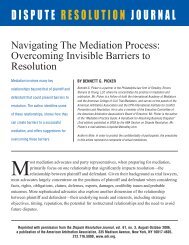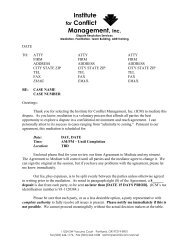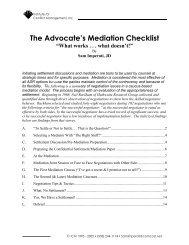17 e-Mediation - Mediate.com
17 e-Mediation - Mediate.com
17 e-Mediation - Mediate.com
Create successful ePaper yourself
Turn your PDF publications into a flip-book with our unique Google optimized e-Paper software.
<strong>17</strong> e-<strong>Mediation</strong><br />
Fourth, continuing on the previous points, much of the focus (particularly the early<br />
focus) of ODR was on scale. ODR was seen as particularly effective for handling large<br />
volumes of similar disputes; the service-provider model fits that niche.<br />
Finally, with much of the focus on new technological platforms for delivering e-mediation,<br />
developers were more likely to be business organizations rather than individual<br />
practitioners due to issues of full scale management, cost and expertise.<br />
As a result, in the early days of e-mediation, very few individual practitioners hung out<br />
their web-shingle announcing themselves as such. It is difficult to tell whether this precludes<br />
individual practitioners having been, behind the scenes the sole operator of an e-mediation<br />
service providing site. Most likely, there were some providers with whom this was the case.<br />
However, no visible presence of small-shop mediation practitioners was identified on the<br />
web in Conley Tyler’s 2005 mapping out of the field.<br />
Recently, it would seem that a new trend is developing, of individual practitioners<br />
offering e-mediation services without trying to cloak themselves in a larger organizational<br />
veneer. An English-language search conducted at the end of 2010 turned up ten such<br />
individual practitioners, nine based in the US and one in South Africa (see Pearlstein,<br />
Hanson & Ebner, chapter 19 in this book). What might account for this shifting trend? I<br />
suggest that three converging factors are at play. First, mediation is ever a <strong>com</strong>petitive<br />
market, supply-driven rather than demand-driven, <strong>17</strong> in which every edge a mediator can<br />
gain in attracting cases is of great value. Second, mediators, just like the general population,<br />
are be<strong>com</strong>ing increasingly adept and <strong>com</strong>fortable with technology; taking mediation processes<br />
online seems more of a logical next step and less of a huge, daunting leap. Finally,<br />
the past few years have seen an important increase in the availability of low-to-no cost<br />
platforms for <strong>com</strong>munication. The lack of funding or expertise to develop a “real” ODR<br />
platform is much less of a hindrance now than it was just a few years ago.<br />
Whether these or other reasons are driving the increase in smaller-scale operations<br />
and individual practitioners getting in on the e-mediation market, the practitioners identified<br />
so far are probably just the tip of the iceberg of the pool of mediators out there who<br />
have actually expanded their practice to incorporate conducting mediation by <strong>com</strong>binations<br />
of email, phone and videoconferencing, and we can expect to see this trend increase in<br />
years to <strong>com</strong>e.<br />
3.1.3 Alternative models: Licensing and Partnering<br />
There are some developing models of practice bridging the previous two categories, of<br />
regional/global and of institutional service provider/individual practitioner. These would<br />
involve service providers who have invested in development of advanced platforms offering<br />
<strong>17</strong> Mayer (2004); U. Velikonja, “Making Peace and Making Money: Economic Analysis of the Market for<br />
Mediators in Private Practice”, Alb. L. Rev.(2009) 72.<br />
373



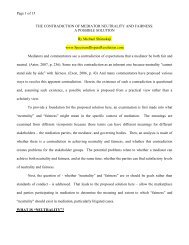

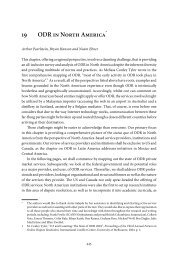
![Settlement Agreement Form [Agreement] - Mediate.com](https://img.yumpu.com/50682143/1/190x245/settlement-agreement-form-agreement-mediatecom.jpg?quality=85)

